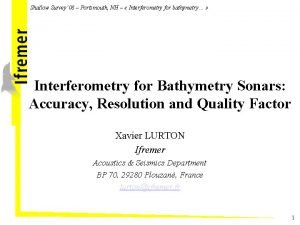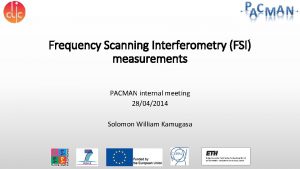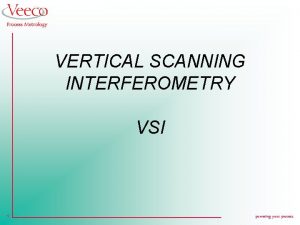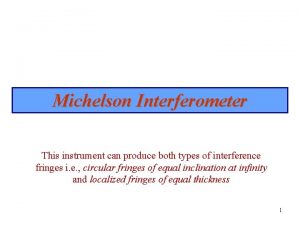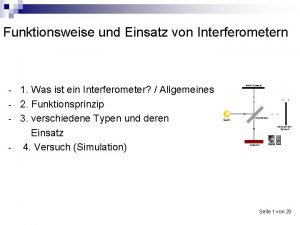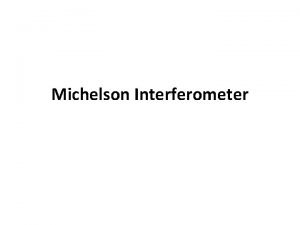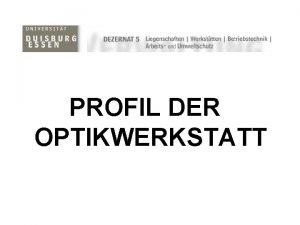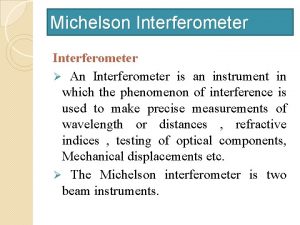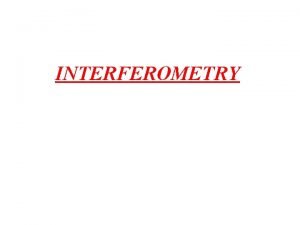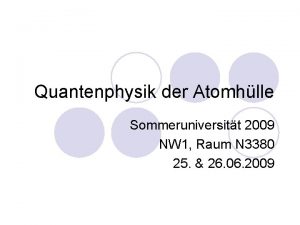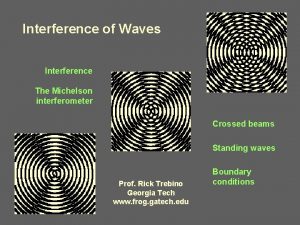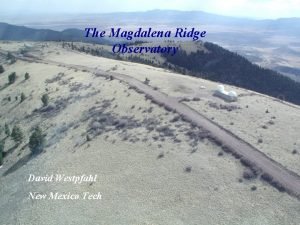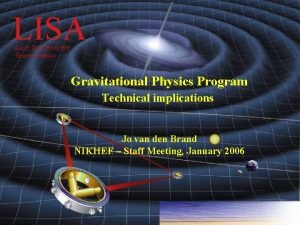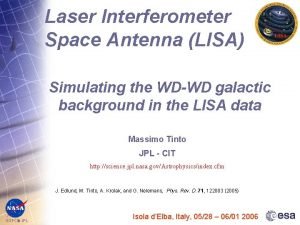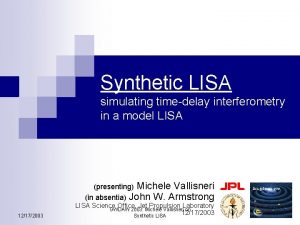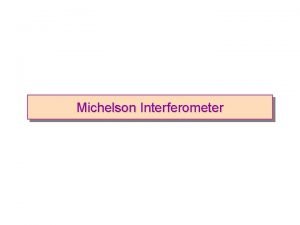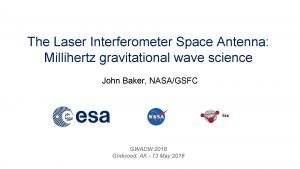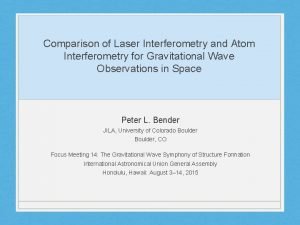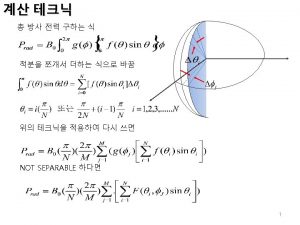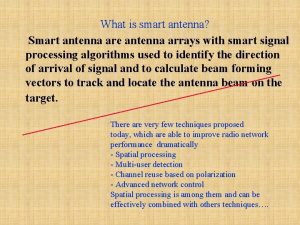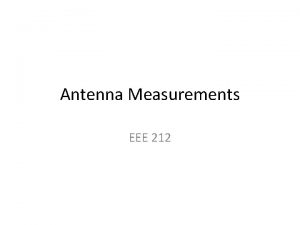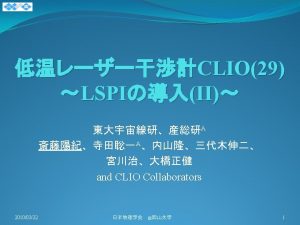Laser Interferometer Space Antenna LISA TimeDelay Interferometry with















- Slides: 15

Laser Interferometer Space Antenna (LISA) Time-Delay Interferometry with Moving Spacecraft Arrays Massimo Tinto Jet Propulsion Laboratory, California Institute of Technology GSFC JPL 8 th GWDAW, Dec. 17 -20, 2003, Milwaukee, Wisconsin

W. M. Folkner et al. , C. Q. G. , 14, 1543, (1997)

Unequal-arm Interferometers L 3 f 3(t) P. D fi = two-way phase measurements er Las n 0, p(t) L 2 P. D f 2(t) S. V. Dhurandhar, K. R. Nayak, and J-Y. Vinet, Phys. Rev. D, 65, 102002 (2002). M. Tinto, & J. W. Armstrong, Phys. Rev. D, 59, 102003 (1999).

Time-delay Interferometry 2 2* L 1 3* o L 3 3 L 2 1 1* • It is best to think of LISA as a closed array of six one-way delay lines between the test masses. • This approach allows us to reconstruct the unequal-arm Michelson interferometer, as well as new interferometric combinations, which offer advantages in hardware design, in robustness to failures of single links, and in redundancy of data. M. Tinto: Phys. Rev. D, 5354 (1996); Phys. Rev. D, 58, 102001 (1998) J. W. Armstrong, F. B. Estabrook, and M. Tinto: Ap. J. , 527, 814 (1999) F. B. Estabrook, M. Tinto, & J. W. Armstrong, Phys. Rev. D, 62, 042002 (2000) M. Tinto, D. A. Shaddock, J. Sylvestre, & J. W. Armstrong: Phys. Rev. D 67, 122003 (2003)

Unequal-arm Interferometers (Cont. ) 3 2 L 3 • One can actually regard X as given by the interference of two beams that propagate within the two arms of LISA, each experiencing a delay equal to (2 L 2 + 2 L 3). • X is actually a zero-area Sagnac Interferometer, synthesized by properly combining measurements from each arm. 1 D. A. Shaddock, M. Tinto, F. B. Estabrook & J. W. Armstrong, Phys. Rev. D, 68, 061303 (R) (2003).

Six-Pulse Data Combinations . 2 1 . L 3 a, b, g, z L 1 L 2 . 3 -- ? ? D. A. Shaddock, M. Tinto, F. B. Estabrook & J. W. Armstrong, Phys. Rev. D, 68, 061303 (R) (2003).

Eight-Pulse Data Combinations . 1 . L 3 (X, Y, Z) Unequal-arm Michelson . L 2 . 2 2 . 3 1 . L 3 L 1 L 2 1 . 2 (E, F, G) L 1 L 2 3 . 2 L 3 . (P, Q, R) Beacon . Monitor 3 1 . L 3 (U, V, W) Relay L 1 L 2 . 3

Moving spacecraft Arrays and Clocks Synchronization • The analysis above assumed the clocks onboard the LISA S/Cs to be synchronized to each other in the frame attached to the LISA array. • In a rotating reference frame, the Sagnac effect prevents the implementation of the Einstein’s Synchronization Procedure, i. e. synchronization by transmission of electromagnetic signals (GPS is a good example of this problem!) • To account for the Sagnac effect, one introduces an hypothetical inertial reference frame, and time in this frame is the one adopted by the spacecraft clocks! • In other words, the onboard receivers have to convert time information received from Earth to time in this inertial reference frame (SSB). N. Asbby, “The Sagnac effect in the GPS System”, http: //digilander. libero. it/solciclos/ M. Tinto, F. B. Estabrook, & J. W. Armstrong, gr-qc/0310017, October 6, 2003

Moving spacecraft Arrays and Clocks Synchronization (Cont. ) • In the SSB frame, the differences between back-forth delay times are very much larger than has been previously recognized. • The reason is in the aberration due to motion and changes of orientation in the SSB frame. • With a velocity V=30 km/s, the light-transit times of light signals in opposing directions (Li, and L’i) will differ by as much as 2 VL (a few thousands km) • They will also change in time due to rotation (0. 1 m/s); this however is significantly smaller than the spacecraft relative velocity (10 m/s).

TDI with Moving spacecraft Arrays • The “first-generation” TDI expressions do not account for: – The Sagnac Effect – Time-dependence (velocity) of the arm lengths in the TDI expressions (the “Flex-effect”) • Both effects prevent the perfect cancellation of the laser frequency fluctuations in the “first-generation” TDI combinations. • With a laser frequency stability of 30 Hz/Hz the remaining laser frequency fluctuations could be as much as 30 times larger than the secondary noise sources. 1/2 D. A. Shaddock, Phys. Rev. D: to appear; gr-qc/0306125 Cornish & Hellings, Class. Quantum Grav. 20 No 22 (21 November 2003) 4851 -4860 D. A. Shaddock, M. Tinto, F. B. Estabrook & J. W. Armstrong, Phys. Rev. D, 68, 061303 (R) (2003).

The Sagnac Effect and the Sagnac Combinations . 2 (a, b, g) 1 . L 3 L 1 . L 2 . 3 2 1 . L 3 L’ 3 L 2 L’ 1 L’ 2 L 1 . • In presence of rotation, the amount of time spent by a beam to propagate clockwise is different by the time it spends to propagate counterclockwise along the same arm => (L 1, L 2, L 3, L’ 1, L’ 2, L’ 3). • The Sagnac effect prevents the perfect cancellation of the laser frequency fluctuations in the existing expressions of the Sagnac combinations (a, b, g, z). • @ 10 -3 Hz the laser frequency fluctuations remaining in (a, b, g, z) would be about 30 times larger than the secondary noise sources. 3 a, b, g a 1 , a 2 , a 3

“Flexy” 3 2 1 D. A. Shaddock, M. Tinto, F. B. Estabrook & J. W. Armstrong, Phys. Rev. D, 68, 061303 (R) (2003).

Systematic Approach • Is there a general procedure for deriving the “ 2 nd generation” TDI combinations? • YES! M. Tinto, F. B. Estabrook, & J. W. Armstrong, gr-qc/0310017, October 6, 2003

Systematic Approach (Cont. ) . 2 1 . L 3 L’ 2 L 2 . 3 =0

How Does the LISA Sensitivity Change? • Once the laser frequency fluctuations are removed, the corrections to the signal and the secondary noises (optical path, proof-mass, etc. ), introduced by the extra delays due to the Sagnac (14 km) and flexy (~ 300 m) effects, are many orders of magnitude below the signals and secondary noises determined by the “ 1 st generation” TDI expressions:
 Laser interferometer space antenna
Laser interferometer space antenna Interferometry
Interferometry Molecult
Molecult Frequency scanning interferometry
Frequency scanning interferometry Vertical scanning interferometry
Vertical scanning interferometry Types of fringes in michelson interferometer
Types of fringes in michelson interferometer Site:slidetodoc.com
Site:slidetodoc.com Prinsip kerja interferometer adalah
Prinsip kerja interferometer adalah Optikwerkstatt
Optikwerkstatt What is the principle of michelson interferometer
What is the principle of michelson interferometer Npl flatness interferometer
Npl flatness interferometer Mach-zehnder-interferometer leifi
Mach-zehnder-interferometer leifi Constructive vs destructive interference
Constructive vs destructive interference Magdalena ridge observatory interferometer
Magdalena ridge observatory interferometer World space computer
World space computer Space junk the space age began
Space junk the space age began

